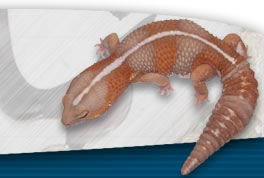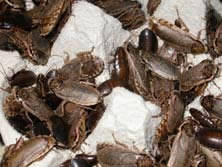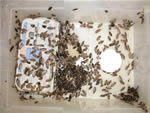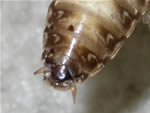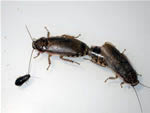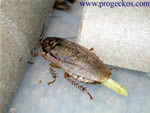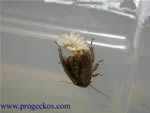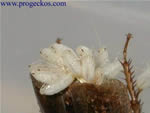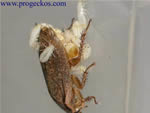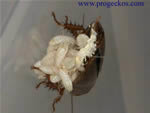

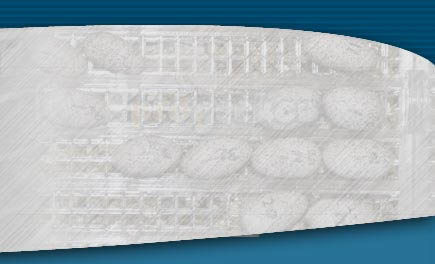

General Information:
Lobster roaches (Naupheta cinerea) are a tropical roach from the Caribbean. They measure around 1¼" in length as adults and are around 3/16” in length when born. Adults have wings but are unable to fly. I have heard that some adults can "flutter" for short distances but I've never witnessed it. This is a climbing species so they are able to climb anything including smooth surfaces like plastic and glass. They are a nocturnal species being more active at night and are very shy and skittish when disturbed. Adults have a life span of around 1 year.Housing:
Housing lobster roaches is very simple. Any container is suitable to use such as but not limited to Rubbermaid containers or glass aquariums. Size does not really matter but will depend on how many roaches you need to keep. I use a 56 quart Rubbermaid for mine. Remember lobsters do climb so to prevent them from getting out of the cage line the top 2-3” of the container with Vaseline. This creates a slick surface that they are unable to get hold of. Another thing to keep in mind is to never overcrowd the container. A for sure sign of this would be short or missing antennas. Overcrowding can also slow production and growth because of the competition for food and hiding areas.Substrate - I suggest not using any type of substrate to minimize maintenance. This will make cleaning much easier and greatly decrease any smell. This roach is also fairly small so they would easily hide making it harder for you to find them.
Hides - Provide plenty of hiding places. This can be achieved by placing several egg cartons, paper towel rolls or toilet paper rolls in the cage. This will let them hide and feel more comfortable. Hiding places are essential for the colony to thrive and to minimize overcrowding.
Heat & Light - Lobsters are nocturnal therefore they should be kept in the darkest area possible where they will be most active. As far as temperatures they like it hot especially for breeding. Ideally keep them around 90-95ºF. During the summer my roaches experience temperatures around 105-110ºF and this is when production and growth is highest. Remember when they are at these extreme temperatures they’ll eat more and need more water to stay hydrated. If they are producing faster than you wish you can bring their temperatures down to 75ºF. They will still thrive but grow and reproduce slower.
Food & Water:
Like all roaches lobsters will eat just about anything they are offered. Highly nutritious items such as various fruits, vegetables, grains etc. are all accepted. Unlike other roach species lobsters don’t require a high protein diet but always remember variety is key. Make sure to gutload all food items for 24 hours prior to feeding. Gutloading is feeding very nutritious/high quality foods (such as the ones listed above) to prey prior to feeding to your animals. There are also many commercially available products that are in powder form. I make and use Pro Gutload for all my feeders. Gutloading will ensure a healthier insect and in the long run a healthier animal.Water - I offer a shallow dish of water and keep it full at all times. They are pretty good at not drowning because they do climb but if you are experiencing drownings a sponge or paper towel may be added to the dish to prevent this issue. This should be cleaned several times a week to prevent bacteria build up and replaced with fresh water. You can also use water gel, fruits and vegetables as a water source.
Maintenance:
Maintenance is minimal when keeping any species of roach. Depending on the amount of roaches you have in a container they should be cleaned on at least a monthly basis but I prefer to do it weekly. This can be done by sifting the roaches from the waste but with the lobster I prefer to use a brush and scoop. The babies are so tiny I want to make sure they aren’t mixed in with the waste. Regular cleaning will reduce smell and the potential for bacteria build up. Also make sure they have fresh clean water and food at all times. Every few weeks to a month change the egg cartons. Every few months the Vaseline will need cleaned and new being applied back to the surface. This will keep the Vaseline from getting dirty and giving the roaches a chance to get hold of it.Breeding:
Roaches are probably the easiest creature in the world to breed. All they really need is suitable housing, food, water and heat. The lobsters are one of if not the fastest breeding roach being used as a feeder. In a small amount of time you can build up to an endless and I mean endless supply of food.Sexing - This can be a little trickier than other roach species. Males are generally smaller and females are much wider and thicker. After quite a bit of time looking for differences in the adults I finally found one. Turn the roach over and look at the underbelly near the tip of the abdomen. Females have 2 small white dots with a small white line on each pointing to the center (median) of the abdomen. If a line was drawn down the middle of the roach these dots and lines would appear as a mirror image on each side. Males however lack these dots and lines. Generally lobsters don’t need sexed (unless to feed off males) as they produce so fast.
Breeding - The roaches mature at 3 months of age depending on temperature. This is the stage where they can start reproducing. Soon you will see the females getting larger. You might even witness a female extracting their egg case called an ootheca. Do not disturb them when they are doing this! If disturbed you may loose the babies. Once the egg case is extracted the female then retracts it back inside a special cavity. This is where the babies develop and the female gives birth to 20-30 live babies after about a month gestation. The best part about lobsters is they give live birth so no incubation is needed.
As a feeder - Roaches make excellent feeders for your reptiles. They are high in protein and have a good shell to meat ratio. Animals will readily take them as they don’t give off any defensive odor. Because these roaches do climb they can be a little tricky to feed. If your animal eats them right away you can feed them live. If your cage is large enough you can use a container lined with Vaseline and add live roaches or just line the cage itself. You can also pinch their heads and place them in a dish. They will wiggle around but are unable to function properly. As long as they have Vaseline around their container there is really no worry about them escaping.
Conclusion:
Lobsters have steadily gained in popularity as a feeder because they breed so fast and it’s free food. I’ve found they work very well as a feeder and are readily accepted by reptiles. If you want an easy to care for roach and an endless supply of food lobster roaches may just be for you.

